Movie Review – King Kong (1976)
While it’s dated horribly in terms of the spectacle, and the costumes, and the musical score, the 1976 Kong is still an entertaining package for the majority of its time on the screen. Although hindered by a glacial opening act, and a befuddling performance by an apparently intoxicated Jessica Lange (in her screen debut), the film still retains a sense of fun and adventure mixed with its utterly obvious statements about big business, greed, and the environmental destruction occurring on a daily basis. About an hour or so longer than the original, while telling almost the exact same story beat-for-beat, but nowhere near as contorted as Peter Jackson’s 2005 effort, the ’76 Kong is worth a look for a time-capsule for “blockbuster” entertainment before the term was even coined.
– Summary –
Director : John Guillermin
Year Of Release : 1976
Principal Cast : Jeff Bridges, Charles Grodin, Jessica Lange, John Randolph, Rene Auberjonois, Ed Lauter, Julius Harris, Ed O’Halloran, Dennis Fimple, Jorge Moreno, Mario Gallo, Sid Conrad, Corbin Bernsen.
Approx Running Time : 134 Minutes
Synopsis: A Big Oil exec travels to a mysterious island in search of the next big fuel discovery, only to find the island inhabited by an enormous ape. Seeing an opportunity to make a fortune, he transports the ape back to show in New York City. Naturally (because this is a movie) things don’t go according to plan.
What we think : While it has dated horribly in terms of the spectacle’s technical merits, and the costumes, and the musical score, the 1976 Kong is still an entertaining package for the majority of its time on the screen. Although hindered by a glacial opening act, and a befuddling performance by an apparently intoxicated Jessica Lange (in her screen debut), the film still retains a sense of fun and adventure mixed with its utterly obvious statements about big business, greed, and the environmental destruction occurring on a daily basis. About an hour or so longer than the original, while telling almost the exact same story beat-for-beat, but nowhere near as contorted as Peter Jackson’s 2005 effort, the ’76 Kong is worth a look for a time-capsule for “blockbuster” entertainment before the term was even coined.
**********************
Yeah, if I was an ape I’d still want a peek at Lange’s boobies.
It’s a brave film-maker who dares remake – or even sequelize – a classic Hollywood film, and King Kong was such an iconic entry into the canon that even the very thought of remaking it teetered on sacrilege. So super-producer Dino De Laurentiis’ attempt to remake the story no doubt caused fans of the original some slight palpitations. The remake of King Kong, released by Paramount in 1976, features some fairly decent visual effects, and some big-budget effort on behalf of the the production to out-do Merian C Cooper’s original black-n-white adventure. Twice as long as the original Kong, and yet still telling the same story (almost beat-for-beat), director John Guillerman (The Towering Inferno, Death On The Nile, Sheena, and the eventual sequel to this movie, King Kong Lives) stages the action with a more modern acuity and a truly 1970’s blockbusting sense of epic thrills. Led by a hippie-looking Jeff Bridges, a conniving Charles Grodin (chewing the scenery with relish), and a truly bizarre performance by Jessica Lange, King Kong’s 1976 iteration isn’t entirely a “should never have been made” cause, and remains a fairly fun, effortlessly zany cinematic effort.
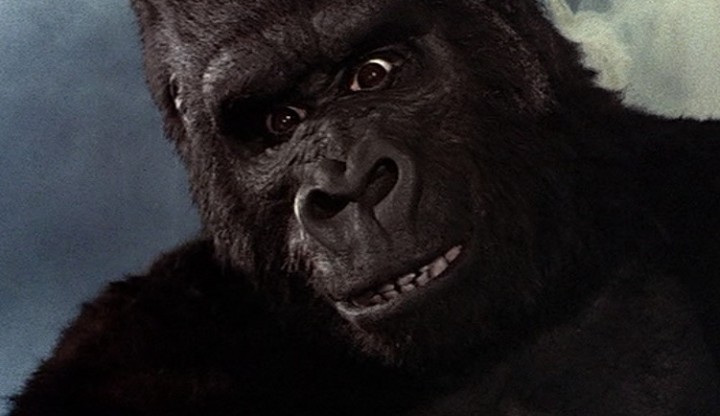
Plot synopsis courtesy Wikipedia: Fred Wilson (Charles Grodin), an executive of the Petrox Oil Company, forms an expedition based on infrared imagery which reveals a previously undiscovered Indian Ocean island hidden by a permanent cloud bank. Wilson believes the island has a huge deposit of oil. Jack Prescott (Jeff Bridges), a primate paleontologist who wants to see the island for himself, stows away on the expedition’s vessel. Prescott reveals himself when he warns the crew the cloud bank may be caused by an unknown beast. Wilson orders Prescott locked up, claiming that he is really a spy from a rival oil company. While escorted to lock-up, Prescott spots a life raft which carries the beautiful and unconscious Dwan (Jessica Lange). Wilson conducts a thorough background check on Prescott and realizes he is telling the truth. He appoints Prescott the expedition’s official photographer and requests that he be present when Dwan revives because of his medical background. Upon waking, Dwan says she is an aspiring actress who was aboard a director’s yacht which suddenly exploded. On arriving at the island, Wilson soon discovers that the oil there is wholly unsuited to fuel production – embittered, he focuses his attention on capturing the local giant ape, whom the savage inhabitants have named “Kong”, to use as a promotional tool for Petrox. Kong captures Dwan, who is then rescued by Prescott, before falling into Wilson’s trap and being transported back to New York, where he is put on display for all the world to see. Which would be okay if he didn’t escape, running amok in New York!
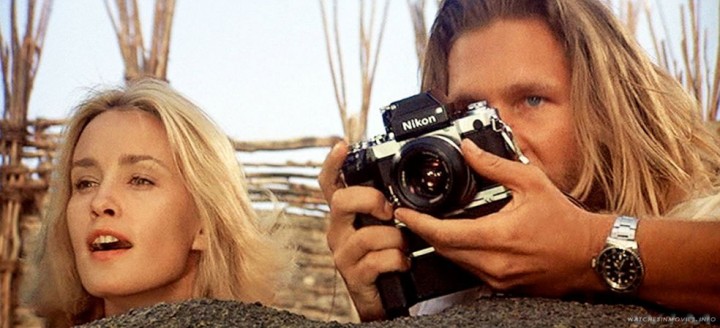
I mentioned in my review of the 1933 King Kong that that film was the early 30’s equivalent of a Michael Bay blockbuster, delivering stunning (for the time) visual effects, a thrifty story and some nicely mounted set-pieces, the most iconic of which is surely Kong’s ascent of the Empire State Building. Dino De Laurentiis, who to that point had produced a trio of recent hits in Death Wish (with Charles Bronson), Serpico (with Al Pacino), and Barbarella (with Jane Fonda), turned his attention to the famous story of the giant ape who falls to his death protecting a blonde bombshell, and decided to do something in the industry which was still relatively rare – remake it. While we look at remakes today and scoff at their general unnecessary-ness, in the mid-70’s a remake was less frowned upon by audiences, most of whom might have been unaware of a remake’s origins. Not so with Kong, a film which permeated the cultural landscape (and still does, offering inspiration to modern-day filmmakers such as Peter Jackson and Steve Spielberg) and which, for many, was/is an untouchable icon of the medium. De Laurentiis’ idea was, like most remakes of older films, modernize the idea and throw a bunch of money at some dazzling visual effects, which would supersede the original’s by an order of magnitude (which they do), and drag more audiences into the cinema to witness – as the promotional poster declared – “The most exciting original motion picture event of all time”. A bold claim, considering the script for this film is almost a direct copy of the ideas and plot twists of the original film!
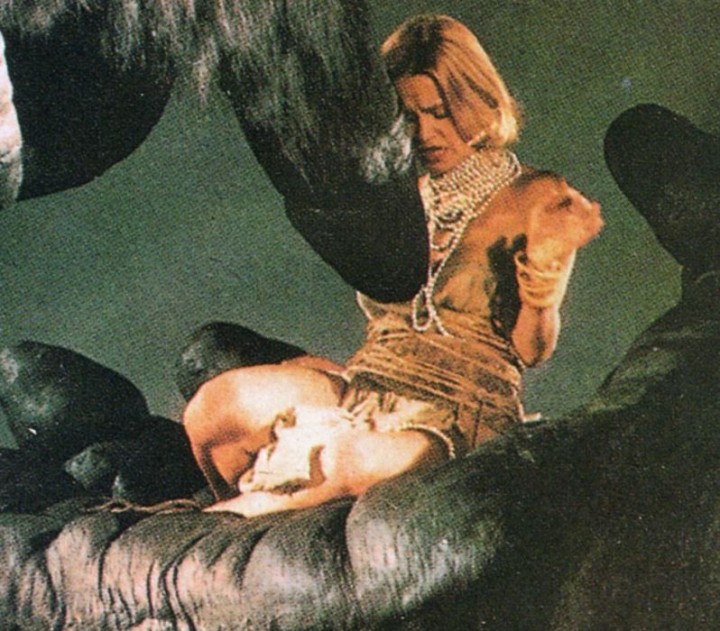
Let’s face it, the main draw of Kong remains seeing the giant ape tear into the city of New York, the resultant destruction a precursor to modern-age blockbusters for whom the Big Apple has become di rigueur for iconic decimation. The finale of the 1976 Kong tries to one-up Cooper’s effort by having giant ape conquer Manhattan’s World Trade Center – a factor now somewhat emotionally awkward since the building’s destruction on 9/11 – because back in 1933, Cooper didn’t have access to the two most prominent constructs of the New York city skyline. Cultural cringe notwithstanding, this King Kong movie, much like Cooper’s version, goes all out with the destruction and “man in suit” carnage. Although here, the film lacks the emotional resonance thanks to a largely blank-slate approach to the characters, who straddle the overly serious (Bridges), the vapidly kooky (Lange), and kitschy nasty (Grodin) but offer little depth or lasting resonance.
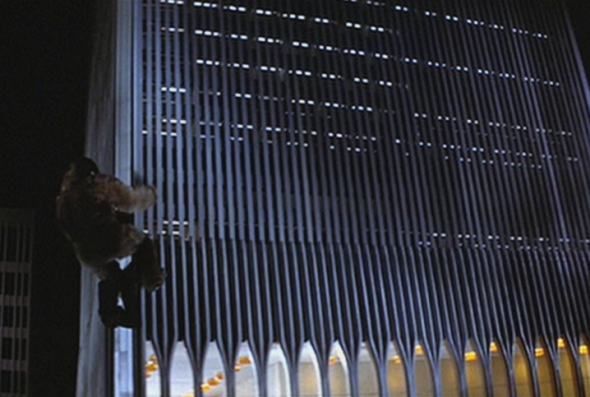
King Kong is nothing if not a film built upon its spectacular visual effects. Kong’s first appearance through the jungle of Skull Island is actually downplayed to a large degree, as if we all know who’s coming to scoop Dwan off her sacrificial altar; Guillerman gets into the action once Kong does arrive, after spending the first third of this two-hour-plus movie on board the Petrox naval ship setting up the cannon fodder characters. The use of rotoscoping, green screen and miniature landscapes to juxtapose the scale of the giant ape is – by 70’s standards – still mostly seamless, although compared to today’s CG-driven spectacles will obviously make the casual viewer snicker just a little. Kong’s escape into New York is the defining moment of the movie, and much like the original film is almost entirely set during the middle of the night! Why hide Kong in darkness for his most iconic moments? Why not set the finale during the day, so we can see what’s going on? Talk about frustrating! Still, the effects here did snag an Academy Award, so I guess I should quit complaining while I’m ahead. Complementing the special effects is DP Richard Kline’s magnificent cinematography – the film’s three Oscar nominations included one for Kline’s work, although he lost out.
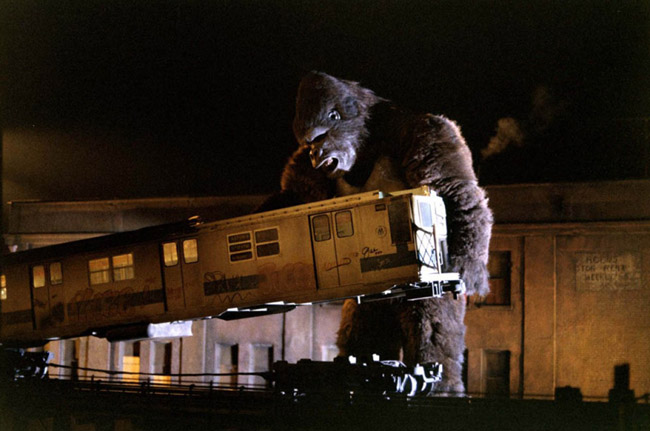
Kudos to Bridges for his work here as Prescott (analogous to the original film’s Jack Driscoll), who offers the limited “primate paleontologist” role at least more than a cursory glimmer of importance. While he’s not on screen as often as he should be, in light of the film’s time taken even getting to the island (which still makes Jackson’s 3 hour epic feel positively rushed by comparison), Bridges commands the screen whenever he does appear, and it’s just a shame he wasn’t given more to do. Grodin’s teeth-baring, fist-shaking Wilson, this film’s Carl Denham, is a fairly stock villain – driven by greed and a lust for fame, his motivation lacks truth behind the cruelty, leaving his more generic than he probably should have been. The script doesn’t dwell on his underlying motivations long enough, or with enough focus, to make him convincing as anything other than simplistic villainy. Keen eyes will note Jack O’Halloran, Superman II’s Non, as a shipmate aboard the Petrox vessel, and an uncredited Corbin Bernsen as a New York reporter.
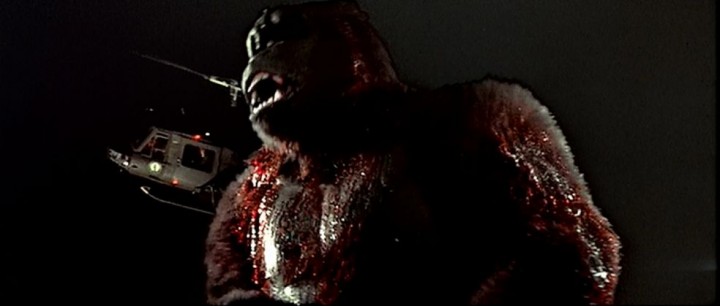
And then there’s Jessica Lange, in her first screen role, as Dwan (apparently, Dwan swapped the middle two letters of her name from Dawn, just to be different, which tells you a little about the screenwriting on this film as it does about how her character is to be played). For some reason, the production decided to make Lange play the part as if she was high on drugs, making the part less an Ann Darrow echo and more a casual-skimpy-bikini-model-ditzy-flirty blonde bombshell on which the camera could focus quite creepily. In fact, the film is filled with eye-rollingly bad camera angles on Lange, as her… ahem, assets are paraded about at virtually every opportunity, not even mentioning the single most creepy moment I’ve seen in modern film to-date – the moment a lusty Kong flicks Dwan’s top off to reveal her bosoms, a moment that will linger long not for the parade of boobs but for the look on Kong’s face as he does so – somewhere between casual pervert and full-fledged sexual deviant, I thought. Lange seems to play the role as if she’s in on the joke, but the character is so shockingly written and – if I’m honest – acted by Lange that it removes a lot of the focus from the ape-proceedings. To think, Lange snagged a Golden Globe for her work here. Unbelievable.
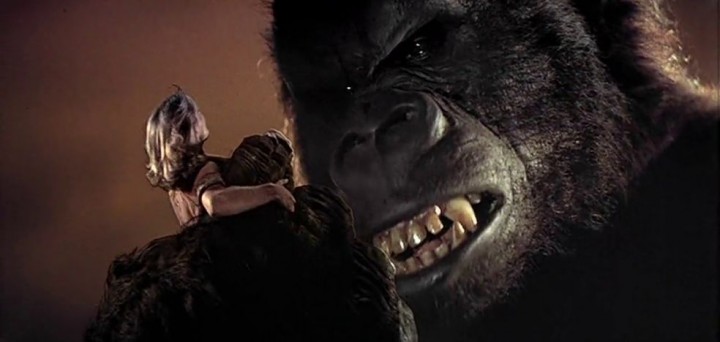
Aside from Kong’s overly sexual advances to something one hundredth his size, King Kong’s bright tone and adventurous themes still resonate. So much so, I was prepared to overlook some of the more dated elements of the movie. This remake taps into that greed-and-human-desire tangent well, albeit a little overcooked, while Lange’s borderline institution-ready performance makes this fun on such a crazy, scattershot level it really does become its own sub-movie all on its own. The scale of the production rightly exceeds that of Cooper’s earlier effort, although the translation through a more modern lens lacks the sharp edges the 33 edition had, at the expense of making Kong either a creepy deviant or an anger-management-issue case for animal rights activists. In all honesty, I did have fun with this as a purely visual, brainless exercise, knowing full well that ’76 Kong lacks the immediacy and intricate style of the ’33 edition, but for what it’s worth, this King Kong is entertaining in most regards.


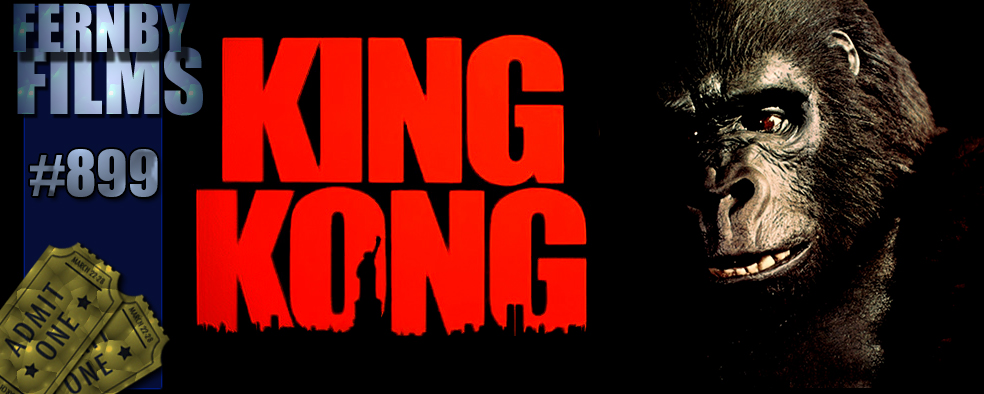









I do enjoy watching this one. My favourite Kong movie is the original 1930s one but I love seeing this thanks to enjoying the ride in Florida so many times as a kid.
My recent post Top 10 Films of John Cusack
I have to say, of the films of King Kong, this one is easily now my 2nd favorite, behind the original. I have to watch this again just for Jessica Lange's utterly nutcase performance!